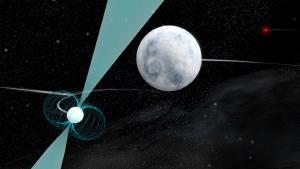Blog
Triple Play
9 January 2014
 Bill Saxton; NRAO/AUI/NSF
Bill Saxton; NRAO/AUI/NSFA new paper in Nature has announced the discovery of a triple star system consisting of two white dwarf stars and a neutron star.1 This has the potential to be a very big deal, because it may allow us to further test general relativity.
General relativity has passed every experimental test so far, but these tests are of “weak field” effects. This means we have confirmed the first-order effects of general relativity, but not the higher order ones. You can get an idea of what this means by imagining the number π. It is as if Newton predicted π was 3.14 exactly, but Einstein predicted it was 3.14159265, and we have experimentally confirmed that π is 3.14159 give or take a bit.
To measure gravity more precisely, we need to look at situations where strong gravitational interactions occur. And we need to be able to measure these interactions very precisely. This new system has two important features that should allow us to do that.
Firstly, the neutron star in the system is a pulsar. Its strong magnetic field produces a beam of radio waves, and as the neutron star rotates the beam sweeps in our direction. As a result, we see a burst of radio energy with each rotation of the neutron star. The neutron star makes about 366 rotations per second, so this allows us to make very precise measurements of its position and motion.
Secondly, the stars of this system are particularly close. The neutron star and one of the white dwarfs orbit each other at a distance of about 15 times the distance from the Earth to the Moon. Keep in mind, these are two stars that are orbiting at this distance, so they are remarkably close. They orbit each other about once every two days. The other white dwarf orbits this pair at roughly the same distance as the Earth from the Sun. So this is a system that has three stars within the space of Earth’s orbit.
So this system will allow us to make precision observations of a high gravity situation. This is close enough that it might also allow us to test the fundamental concept of general relativity, known as the equivalence principle.
The simple version of the equivalence principle is that (neglecting air resistance) any two objects will fall at the same rate, regardless of their mass. This is sometimes known as the weak equivalence principle, and has been confirmed experimentally. But general relativity presumes a stronger version of the principle, which states that the inertial and gravitational mass of an object are the same, regardless of the type of material that makes up that object. If general relativity is correct, then the outer white dwarf will interact gravitationally with the neutron star and the other white dwarf in the same way.
So through close observation of this system, we might be able verify a fundamental aspect of Einstein’s theory of gravity. Or we might discover that Einstein didn’t quite get it right, and that would be cool too.
Ransom, Scott M., et al. “A millisecond pulsar in a stellar triple system.” Nature 505.7484 (2014): 520-524. ↩︎